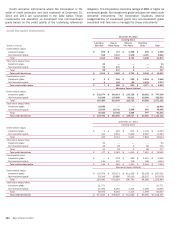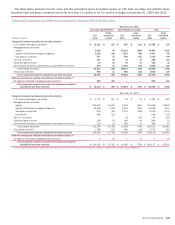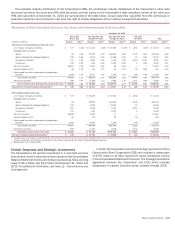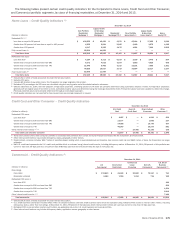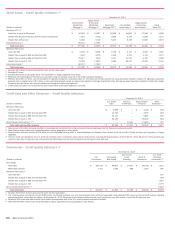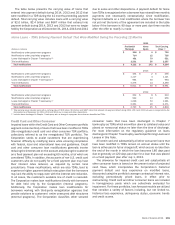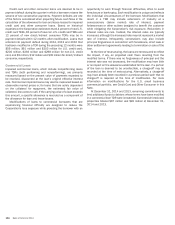Bank of America 2014 Annual Report Download - page 176
Download and view the complete annual report
Please find page 176 of the 2014 Bank of America annual report below. You can navigate through the pages in the report by either clicking on the pages listed below, or by using the keyword search tool below to find specific information within the annual report.
174 Bank of America 2014
The table below presents the Corporation’s nonperforming
loans and leases including nonperforming TDRs, and loans
accruing past due 90 days or more at December 31, 2014 and
2013. Nonperforming loans held-for-sale (LHFS) are excluded from
nonperforming loans and leases as they are recorded at either fair
value or the lower of cost or fair value. For more information on
the criteria for classification as nonperforming, see Note 1 –
Summary of Significant Accounting Principles.
Credit Quality
December 31
Nonperforming Loans
and Leases (1)
Accruing Past Due
90 Days or More
(Dollars in millions) 2014 2013 2014 2013
Home loans
Core portfolio
Residential mortgage (2) $ 2,398 $ 3,316 $ 3,942 $ 5,137
Home equity 1,496 1,431 ——
Legacy Assets & Servicing portfolio
Residential mortgage (2) 4,491 8,396 7,465 11,824
Home equity 2,405 2,644 ——
Credit card and other consumer
U.S. credit card n/a n/a 866 1,053
Non-U.S. credit card n/a n/a 95 131
Direct/Indirect consumer 28 35 64 408
Other consumer 118 12
Total consumer 10,819 15,840 12,433 18,555
Commercial
U.S. commercial 701 819 110 47
Commercial real estate 321 322 321
Commercial lease financing 316 41 41
Non-U.S. commercial 164 —17
U.S. small business commercial 87 88 67 78
Total commercial 1,113 1,309 221 204
Total loans and leases $ 11,932 $ 17,149 $12,654 $ 18,759
(1) Nonperforming loan balances do not include nonaccruing TDRs removed from the PCI loan portfolio prior to January 1, 2010 of $102 million and $260 million at December 31, 2014 and 2013.
(2) Residential mortgage loans in the Core and Legacy Assets & Servicing portfolios accruing past due 90 days or more are fully-insured loans. At December 31, 2014 and 2013, residential mortgage
includes $7.3 billion and $13.0 billion of loans on which interest has been curtailed by the FHA, and therefore are no longer accruing interest, although principal is still insured, and $4.1 billion and
$4.0 billion of loans on which interest is still accruing.
n/a = not applicable
Credit Quality Indicators
The Corporation monitors credit quality within its Home Loans,
Credit Card and Other Consumer, and Commercial portfolio
segments based on primary credit quality indicators. For more
information on the portfolio segments, see Note 1 – Summary of
Significant Accounting Principles. Within the Home Loans portfolio
segment, the primary credit quality indicators are refreshed LTV
and refreshed FICO score. Refreshed LTV measures the carrying
value of the loan as a percentage of the value of the property
securing the loan, refreshed quarterly. Home equity loans are
evaluated using combined loan-to-value (CLTV) which measures
the carrying value of the combined loans that have liens against
the property and the available line of credit as a percentage of the
value of the property securing the loan, refreshed quarterly. FICO
score measures the creditworthiness of the borrower based on
the financial obligations of the borrower and the borrower’s credit
history. At a minimum, FICO scores are refreshed quarterly, and in
many cases, more frequently. FICO scores are also a primary credit
quality indicator for the Credit Card and Other Consumer portfolio
segment and the business card portfolio within U.S. small
business commercial. Within the Commercial portfolio segment,
loans are evaluated using the internal classifications of pass rated
or reservable criticized as the primary credit quality indicators. The
term reservable criticized refers to those commercial loans that
are internally classified or listed by the Corporation as Special
Mention, Substandard or Doubtful, which are asset quality
categories defined by regulatory authorities. These assets have
an elevated level of risk and may have a high probability of default
or total loss. Pass rated refers to all loans not considered
reservable criticized. In addition to these primary credit quality
indicators, the Corporation uses other credit quality indicators for
certain types of loans.


